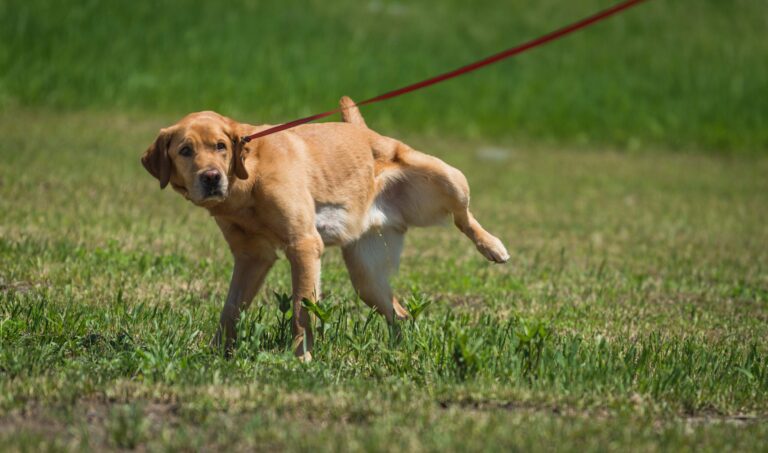To get a urine sample from a dog, use a clean container to collect mid-stream urine while the dog is urinating. If your veterinarian has requested a urine sample from your dog, it may seem daunting at first.
However, with the right approach, it can be achieved relatively easily. By knowing the correct methods and understanding the importance of the sample, you can successfully collect the urine sample from your dog. We will discuss the step-by-step process of how to get a urine sample from a dog, including the tools needed and the best practices to follow.
Whether you are a pet owner or a veterinary professional, having the ability to obtain a urine sample from a dog is an essential skill for ensuring the good health of the canine patients.

Credit: porchpotty.com
Understanding The Basics
Collecting a urine sample from a dog is important for diagnosing various health conditions. Some common reasons for obtaining a urine sample include monitoring overall health, detecting underlying diseases, and evaluating kidney function. There are different methods for collecting urine from a dog, such as cystocentesis, free catch, and manual expression. Each method has its own advantages and considerations. Cystocentesis is often preferred as it provides a sterile sample. Essential tools for the procedure may include gloves, sterile containers, and cotton balls. Proper understanding of the basics and methods for urine collection is crucial for ensuring accurate and reliable results.
Expert Tips For Collection
If you want to get a urine sample from your dog, it’s best to choose a comfortable and familiar location at a time when your dog is relaxed. It’s important to familiarize your dog with the collection process. Using treats and positive reinforcement can help your dog feel more at ease and willing to provide a sample. You can also try to create a positive association with the collection process by offering rewards or verbal praise. With patience and consistency, you can make the urine collection process a stress-free experience for both you and your pet.
Preparing For The Task
When preparing to collect a urine sample from a dog, gathering the necessary materials such as a clean container, gloves, and treats is essential. Ensure you have gloves to maintain hygiene during the process. It is also important to mentally prepare your dog for the procedure by creating a calm environment and using positive reinforcement. Give your dog time to relax and make sure they are well-hydrated to ease the process of obtaining the sample. Remember to approach the task with patience and understanding to minimize stress for your pet.
Collecting The Sample
Collecting a urine sample from a dog can be done by using positioning techniques that help in successful collection. Minimizing contamination during the process is crucial to ensure the accuracy of the sample. Furthermore, handling the urine sample post-collection needs to be done with care to avoid any compromise in the integrity of the sample. By following these steps, you can effectively obtain a urine sample from your dog for the necessary testing.
Ensuring Dog Comfort And Safety
When collecting a urine sample from your dog, it is crucial to ensure their comfort and safety throughout the process. Maintaining a calm environment is essential for reducing stress and anxiety in your pet. Once the sample has been collected, provide immediate care to your dog by offering praise, comfort, and their favorite treats. Additionally, monitor your dog for any signs of distress, such as excessive panting or unusual behavior, to ensure their well-being. By prioritizing your dog’s comfort and safety, you can effectively obtain a urine sample while minimizing their stress levels.
When To Contact A Vet
It is important to consult a vet if common complications in urine collection occur. Situations that require professional assistance include difficulty in getting a urine sample, if the dog is in extreme pain or discomfort, or if there is blood in the urine. Professional help is also necessary if the dog is showing signs of illness or if the urine sample is needed for a specific medical examination.
Preserving The Sample Quality
When collecting a urine sample from your dog, it is important to store the sample appropriately to maintain its quality. Keep the sample refrigerated if you are unable to transport it to the vet or laboratory immediately. A clean, leak-proof container should be used for storage to prevent contamination. When transporting the sample, make sure it is securely sealed and labeled with your dog’s information. It is important to deliver the sample to the vet or laboratory as soon as possible to ensure accurate test results. Proper storage and transportation of the urine sample are crucial in preserving its quality and obtaining reliable diagnostic information.
Choosing The Ideal Collection Method
When to use manual expression or catheterization: If your dog is skittish, non-invasive techniques such as manual expression or catheterization may be ideal for obtaining a urine sample. Manual expression is a gentle method that involves applying external pressure to the bladder, while catheterization uses a small tube to collect urine from the bladder. Both techniques can be effective for dogs that are uncomfortable with traditional collection methods. However, it’s important to consult with a veterinarian to determine the best approach for your dog’s specific needs.
Training Your Dog For Sample Collection
When it comes to getting a urine sample from your dog, the process can be made much simpler through gradual introduction to collection cups. Start by bringing the cup around your dog during routine activities to familiarize them with it, using commands and cues to facilitate cooperation during the process. By associating the cup with positive experiences and using positive reinforcement, your dog should become more comfortable with the cup. It’s important to take your time and be patient, as rushing can lead to stress and resistance. With consistency and gentle encouragement, your dog can be trained to provide urine samples without difficulty.
Timing And Frequency Insights
Best times of day to collect a urine sample: When obtaining a urine sample from a dog, it is best to collect the first morning urine, as it is the most concentrated and provides the most accurate results. Additionally, a sample can be collected after a period of rest, as this will also yield a more concentrated urine sample.
Frequency of collection for accurate diagnosis: To ensure an accurate diagnosis, it is recommended to collect urine samples at the frequency prescribed by your veterinarian. This may involve collecting multiple samples over a period of time, especially if the dog’s condition is being monitored or tested for specific health issues. Following the veterinarian’s guidelines for sample collection frequency is crucial for an accurate diagnosis and treatment plan.
With Patience And Practice
When it comes to getting a urine sample from a dog, it’s important to approach the process with patience and practice. Acclimating your dog to the procedure is essential for a smooth and stress-free experience. Start by introducing your dog to the collection materials, such as the container and location, in a familiar and comfortable environment. Gradually associate positive experiences, such as treats and praise, with the process to reduce anxiety. Maintain a calm demeanor and be patient, allowing your dog to adjust at their own pace. Consistency and gentle encouragement are key to successfully obtaining a urine sample from your dog. Remember, the more practice and patience you incorporate, the easier the process will become for both you and your canine companion.
Practical Tools And Alternatives
When it comes to collecting a urine sample from a dog, there are practical tools and alternatives to consider. DIY collection tools, such as non-absorbent non-stick disposable containers or non-absorbent non-stick pie plates, can be used when a professional collection kit is not available. It’s important to gauge the situation and determine when these DIY tools are suitable. For accurate results, professional collection kits designed specifically for dog urine samples should be used. These kits often include urine collection cups, pipettes, and storage vials, ensuring a hygienic and controlled process. By understanding the options available, pet owners can effectively collect urine samples from their dogs when needed.
Overcoming Common Challenges
Collecting a urine sample from a dog can be challenging, especially when dealing with uncooperative dogs. For small breeds or puppies, using non-absorbent litter in a clean container can encourage them to urinate. If this method doesn’t work, taking the dog for a walk to encourage urination can be effective. Additionally, gently massaging the dog’s bladder or using a urine collection aid may help. It’s important to remain patient and reassuring while attempting to collect the sample. Ensuring the environment is calm and comfortable can also encourage the dog to urinate. Remember to consult with a veterinarian for specific advice tailored to the dog’s needs.
Frequently Asked Questions Of How To Get A Urine Sample From A Dog
How Do You Collect A Urine Sample From A Dog?
To collect a urine sample from your dog, use a clean container to catch the urine midstream. For males, gently guide their leg up. For females, place the container close as they squat. Avoid touching the container to prevent contamination.
What Should I Do If My Dog Won’t Urinate On Command?
If your dog won’t urinate on command, maintain a regular schedule for bathroom breaks, and provide plenty of water. Patiently wait for them to naturally relieve themselves, or consult a professional for further advice.
Are There Any Tips For Gathering A Urine Sample From A Senior Dog?
With a senior dog, you may need to visit the vet for assistance due to potential health concerns. Provide a comfortable and stress-free environment and monitor their habits for the best opportunity to collect a sample.
Is It Possible To Store A Urine Sample From A Dog For A Later Date?
Yes, you can store a urine sample in a clean, sealed container in the refrigerator for a short period, typically no longer than 24 hours. However, it’s best to use a fresh sample whenever possible for accurate testing.
Conclusion
Obtaining a urine sample from your dog can be challenging, but with patience and the proper techniques, it can be done. Remember to always consult with your veterinarian for guidance and assistance. With the right approach, you can ensure the health and well-being of your pet.



